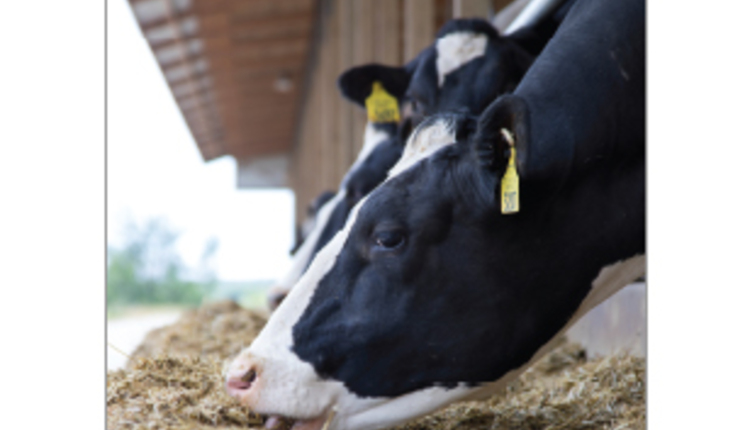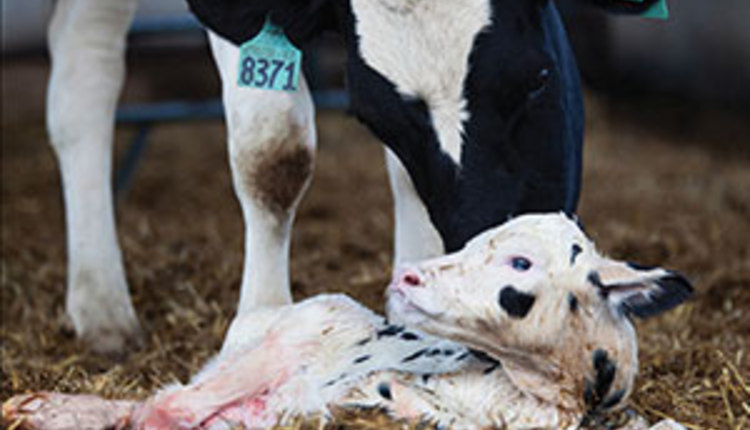
by Coleen Jones, Jud Heinrichs
SPANISH EDITION | Translation by Dr. Victor Mireles.
This book gives you what you need to raise healthy calves. Available in both English and Spanish editions.
CALVING: Maintain the maternity area, Events of a normal calving, Difficult and abnormal births, Examining the cow, Scoring calving difficulty, Abnormal birth positions, Assisting delivery, Twins not a bonus, Care of the newborn calf, Dip the navel of every calf, Don't put off weighing and identification, Give vaccinations and check calf health, Colostrum Q-Q-T rule , Colostrum the essential first meal, Racing the clock, Factors affecting colostrum IgG Antibody concentration is important, Pathogens that spread through colostrum or milk from cow to calf, Cleanliness is a virtue, Measure colostrum quality, Store excess colostrums, Colostrum supplements, Colostrum replacers, Pasteurization of colostrums, Monitor total protein levels, Comparing monitoring methods.
FEEDING: Pre-ruminant digestion, Rumen development, Wait to feed hay, Nutrient requirements, Recommended feeding amount, Calf feeding systems, Liquid feed options and economics, All milk replacers are not created equally, Accelerated growth replacers, Additives can prevent disease, Common milk replacer protein sources, Prebiotics, Evaluating milk replacer quality, Mixing milk replacer, Feeding whole milk, Feeding excess colostrum or transition milk, Recommendations for using fermented milk, Can I feed waste milk to my calves?, Recommendations for feeding waste milk, Waste milk has more microbial life, Pasteurization limits risk, Recommendations to pasteurize waste milk, Quality control, Calf starter composition and qualityWater: the forgotten nutrient, Environmental effects on feed requirements, Calf feeding guidelines from birth to weaning.
HANDLING & HOUSING: Housing influences calf health, Ventilation, Isolate calves to limit disease, Keep calves comfortable, Consider cost and labor efficiency, Options for calf housing.
HEALTH: Dehorning, Removing extra teats, Prevent cross-sucking, Monitoring calf health, Controlling disease requires a comprehensive approach, Causes of scours, What is calf scours? Dehydration kills calves, Bacteria commonly cause calf scours, Viral infections can complicate disease, Protozoa are another source of infection, Prevention of calf scours, Adsorption and secretion of the intestine, Fluid replacement therapy is best scours treatment, Components of oral rehydration solutions, Recipe for oral rehydration solution, Feed electrolytes in addition to normal milk diet, Antibiotics may not help scouring calves, Respiratory disease is second leading illness, Preventing respiratory disease, Navel infections and hernias, Ringworm, Johne's disease, Parasites.
APPENDICES: Correcting a colostrometer's reading based on temperature, Molecular weights and concentrations of ingredients in rehydration solutions, Comparison of oral rehydration products.
This book gives you what you need to raise healthy calves. Available in both English and Spanish editions.
CALVING: Maintain the maternity area, Events of a normal calving, Difficult and abnormal births, Examining the cow, Scoring calving difficulty, Abnormal birth positions, Assisting delivery, Twins not a bonus, Care of the newborn calf, Dip the navel of every calf, Don't put off weighing and identification, Give vaccinations and check calf health, Colostrum Q-Q-T rule , Colostrum the essential first meal, Racing the clock, Factors affecting colostrum IgG Antibody concentration is important, Pathogens that spread through colostrum or milk from cow to calf, Cleanliness is a virtue, Measure colostrum quality, Store excess colostrums, Colostrum supplements, Colostrum replacers, Pasteurization of colostrums, Monitor total protein levels, Comparing monitoring methods.
FEEDING: Pre-ruminant digestion, Rumen development, Wait to feed hay, Nutrient requirements, Recommended feeding amount, Calf feeding systems, Liquid feed options and economics, All milk replacers are not created equally, Accelerated growth replacers, Additives can prevent disease, Common milk replacer protein sources, Prebiotics, Evaluating milk replacer quality, Mixing milk replacer, Feeding whole milk, Feeding excess colostrum or transition milk, Recommendations for using fermented milk, Can I feed waste milk to my calves?, Recommendations for feeding waste milk, Waste milk has more microbial life, Pasteurization limits risk, Recommendations to pasteurize waste milk, Quality control, Calf starter composition and qualityWater: the forgotten nutrient, Environmental effects on feed requirements, Calf feeding guidelines from birth to weaning.
HANDLING & HOUSING: Housing influences calf health, Ventilation, Isolate calves to limit disease, Keep calves comfortable, Consider cost and labor efficiency, Options for calf housing.
HEALTH: Dehorning, Removing extra teats, Prevent cross-sucking, Monitoring calf health, Controlling disease requires a comprehensive approach, Causes of scours, What is calf scours? Dehydration kills calves, Bacteria commonly cause calf scours, Viral infections can complicate disease, Protozoa are another source of infection, Prevention of calf scours, Adsorption and secretion of the intestine, Fluid replacement therapy is best scours treatment, Components of oral rehydration solutions, Recipe for oral rehydration solution, Feed electrolytes in addition to normal milk diet, Antibiotics may not help scouring calves, Respiratory disease is second leading illness, Preventing respiratory disease, Navel infections and hernias, Ringworm, Johne's disease, Parasites.
APPENDICES: Correcting a colostrometer's reading based on temperature, Molecular weights and concentrations of ingredients in rehydration solutions, Comparison of oral rehydration products.
Book details:
72 pages
Softcover
ISBN: 0-932147-49-6
Copyright 2006








